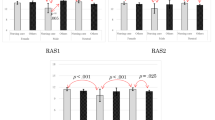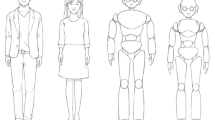Abstract
Although existing studies have suggested that gender stereotypes affect human perceptions about robots, neither what type of robot tasks or roles are expected to show gender characteristics nor whether expected gender characteristics are directly related to conventional gender conceptions have been sufficiently investigated. To explore these issues, this study conducted two online surveys. In the first survey (N = 500) a total of 30 items related to interaction scenes asked whether male, female, or neutral gender was preferred in terms of the appearance of communication partners in these scenes, and five categories regarding the roles and tasks of robots were extracted based on expected gender appearances. The results revealed a weak effect showing higher gender conceptions inviting a female gender appearance preference in some categories. The second survey (N = 400) measured participants’ gender conception, negative attitudes toward robots, gender appearance preferences for the categories of robot roles and tasks extracted in the first survey, and occupations to investigate relationships between them. The results revealed that the influence of gender stereotypes and negative attitudes toward robots on gender appearance preferences changed depending on human occupation, in particular, those with the occupations of counselor, adviser, nurse, and caregiver were not associated with stereotypes, attitudes, or gender preferences toward robots playing roles in their own field of expertise.





Similar content being viewed by others
Data Availability
The data that support the findings of this study are available from the corresponding author, Tatsuya Nomura, upon reasonable request.
References
American Psychological Association (2020) Gender, APA Dictionary of Psychology, (https://dictionary.apa.org/gender)
World Health Organization (2022) Gender and Health, (https://www.who.int/health-topics/gender)
Nomura T (2017) Robots and gender. Gender Genome 1(1):18–25
Siegel M, Breazeal C, Norton MI (2009) Persuasive robotics: the influence of robot gender on human behavior. In: Proceedings of the IEEE/RSJ international conference on intelligent robots and systems, 2009 IROS 2009. October 10–15, 2009. St. Louis, MO. Piscataway, NJ: IEEE, pp 2563–2568
Alexander E, Bank C, Jessica JJ, Hayes B, Scassellati B (2014) Asking for help from a gendered robot. In: Proceedings of the 36th annual conference of the cognitive science society (CogSci2014). July 23–26, 2014. Quebec City, Quebec, Canada. Austin, TX: Cognitive Science Society, pp 2333–2338
Kuchenbrandt D, Ha¨ring M, Eichberg J, Eyssel F (2014) Keep an eye on the task! how gender typicality of tasks influence human–robot interactions. In: The sixth international conference on social robotics. October 27–29. Sydney, Australia. In: Int J Soc Robot, pp 417–427
Ladwig RC, Ferstl EC (2018) What’s in a name? An online survey on gender stereotyping of humanoid social robots. In: Proc. 4th Conference on Gender & IT, May, pp.67–69
Eyssel F, Hegel F (2012) (S)he’s got the look: gender stereotyping of robots. J Appl Soc Psychol 42:2213–2230
Tay B, Jung Y, Park T (2014) When stereotypes meet robots: the double-edge sword of robot gender and personality in human–robot interaction. Comput Hum Behav 38:75–84
Chita-Tegmark M, Lohani M, and Scheutz M (2019) Gender effects in perceptions of robots and humans with varying emotional intelligence. In: Proc IEEE international symposium on human-robot interaction (HRI'19), pp 230–238
Robertson J (2010) Gendering humanoid robots: robo-sexism in Japan. Body Soc 16:1–36
Weber J, Bath C (2007) ‘Social’ Robots & ‘Emotional’ Software agents: gendering processes and de-gendering strategies for ‘Technologies in the Making’. Gender Designs IT: construction and deconstruction of information society technology (Zorn I, Maass S, Rommes E, Schirmer C, Schelhowe H. (eds.), Springer; 53–63
De Angeli A, Brahnam S (2006) Sex stereotypes and conversational agents. Ws. gender and interaction: real and virtual women in a male world
Alesich S, Rigby M (2017) Gendered robots: implications for our humanoid future. IEEE Technol Soc Mag 36(2):50–59
Marchetti-Bowick M (2009) Is your roomba male or female? The role of gender stereotypes and cultural norms in robot design. Intersect: The Stanford J Sci Technol Soc 2(1):90–103
Nomura T (2020) A possibility of inappropriate use of gender studies in human-robot Interaction. AI Soc 35:751–754
Suzuki T, Yamada S, Nomura T, Kanda T (2019) Do people prefer robots over humans as daily communication partners?: relationship to social anxiety in conjunction with the appearance of the robots. J Japan Soc Fuzzy Theory Intell Inform 31(5):789–796
NHK World-Japan (2018) Gender equality in Japan remains bottom”, Dec. 26. (https://www3.nhk.or.jp/nhkworld/en/news/backstories/335/)
Ito Y (1997) The formative factors of gender conception and its relationship with a selection of gender roles in adolescents. Jpn J Educ Psychol 45:396–404
Nomura T, Suzuki T, Kanda T, Kato K (2006) Measurement of negative attitudes toward robots. Interact Stud 7(3):437–454
Song-Nichols K, Young AG (2020) Gendered robots can change children’s gender stereotyping. In Proc CogSci 2020:2480–2485
Rosenberg-Kima RB, Baylor AL, Plant EA, Doerr CE (2008) Interface agents as social models for female students: the effects of agent visual presence and appearance on female students’ attitudes and beliefs. Comput Human Behav 24:2741–2756
Nomura T, Suzuki T, Kanda T, Yamada S, Kato K (2011) Attitudes toward robots and factors influencing them. In: Dautenhahn K, Saunders J (eds) New frontiers in human-robot interaction. John Benjamins Publishing, pp 73–88
Dinet J, Vivian R (2014) Exploratory investigation of attitudes towards assistive robots for future users. Le Travail Humain 77:105–125
Pochwatko G, Giger J-C, Różańska-Walczuk M, Świdrak J, Kukiełka K, Możaryn J, Piçarra N (2015) Polish version of the negative attitude toward robots scale (NARS-PL). J Autom Mob Robot Intell Syst 9(3):65–72
Kanero J, Oranç C, Koşkulu S, Kumkale GT, Göksun T, Küntay AC (2021) Are tutor robots for everyone? The influence of attitudes, anxiety, and personality on robot-led language learning. Int J Soc Robot. https://doi.org/10.1007/s12369-021-00789-3
Weiss A and Spiel K (2021) Should robots have a gender – Should they be gendered? Proc. RO-MAN 2021 workshop on gendering robots: ongoing (Re)configurations of Gender in Robotics, (https://sites.google.com/view/ro-man21-genr-workshop/proceedings)
Stout JG, Wright HM (2016) Lesbian, gay, bisexual, transgender, and queer students’ sense of belonging in computing: an intersectional approach. Comput Sci Eng 18(3):24–30
Acknowledgements
This study was funded by a Grant-in-Aid for Scientific Research (No. 20H05573) from the Japan Society for the Promotion of Science.
Author information
Authors and Affiliations
Corresponding author
Ethics declarations
Conflict of interest
The authors declare that they have no conflicts of interest.
Additional information
Publisher's Note
Springer Nature remains neutral with regard to jurisdictional claims in published maps and institutional affiliations.
Rights and permissions
About this article
Cite this article
Nomura, T., Suzuki, T. Relationships Between Humans’ Gender Conception, Expected Gender Appearances, and the Roles of Robots: A Survey in Japan. Int J of Soc Robotics 14, 1311–1321 (2022). https://doi.org/10.1007/s12369-022-00873-2
Accepted:
Published:
Issue Date:
DOI: https://doi.org/10.1007/s12369-022-00873-2




